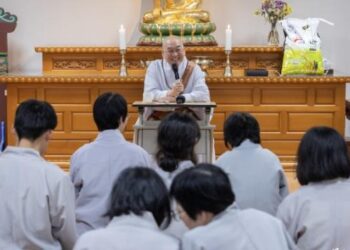2025.11.24. Community Fall Outing, Happy Dialogue (9) Busan
Hello. Today, after completing kimchi-making work with the community members, Sunim went on a fall outing and then held a Happy Dialogue Dharma Q&A in Busan.
After finishing morning practice and meditation, Sunim started the day by working together with the community members from 7:30 AM.
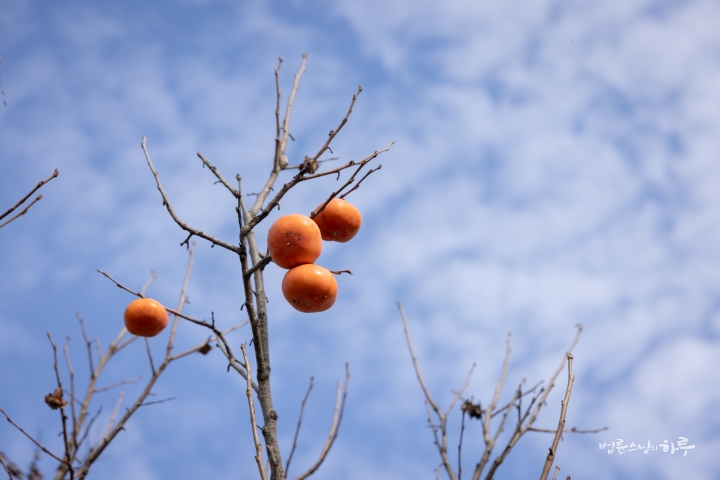
First, Sunim headed to the 200-pyeong field next to the dolmen. The day before yesterday, after harvesting all the cabbages for kimchi-making, they had stacked the cabbages to be taken to Seoul. These cabbages were to be taken to Seoul for the Seoul community members to eat.
First, they loaded 330 cabbages bound for Seoul onto the truck. They carefully packed the cabbages into ton bags, and filled the empty spaces with the remaining radishes and freshly made kimchi without any gaps.
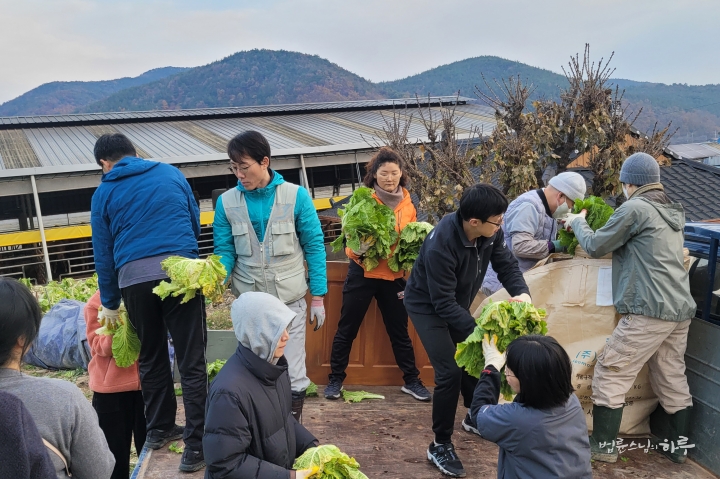
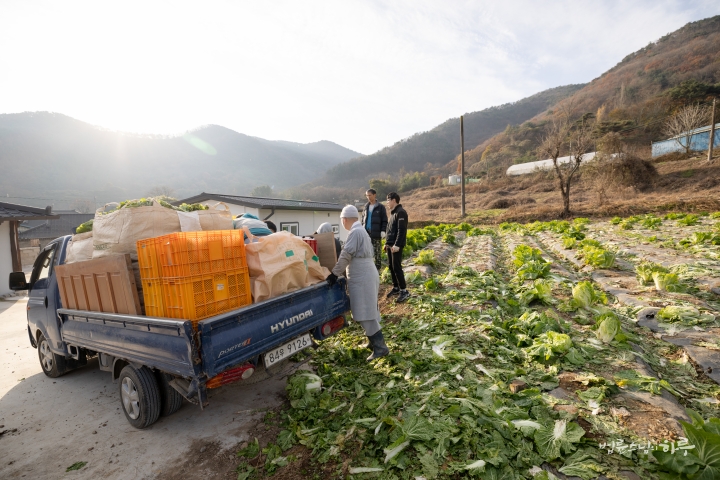
After sending off the truck, they harvested 30 more cabbages for use at Dubuk Jungto Retreat Center and loaded them onto a van.
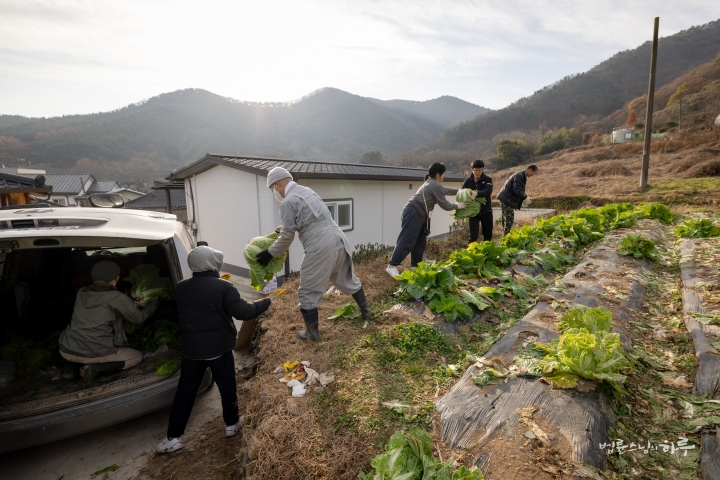

Only small or loosely formed cabbages were left in the field.
“Just leave these cabbages. We can use them for wraps in winter.”
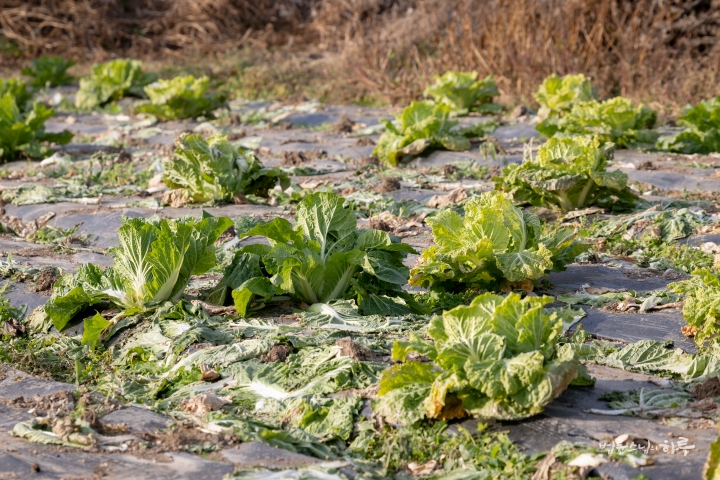
Leaving the field, Sunim headed to the vegetable garden. About 50 cabbages planted in the garden last fall had grown very fresh and healthy. After moving the 30 cabbages brought in the van, they harvested 20 more from the garden.
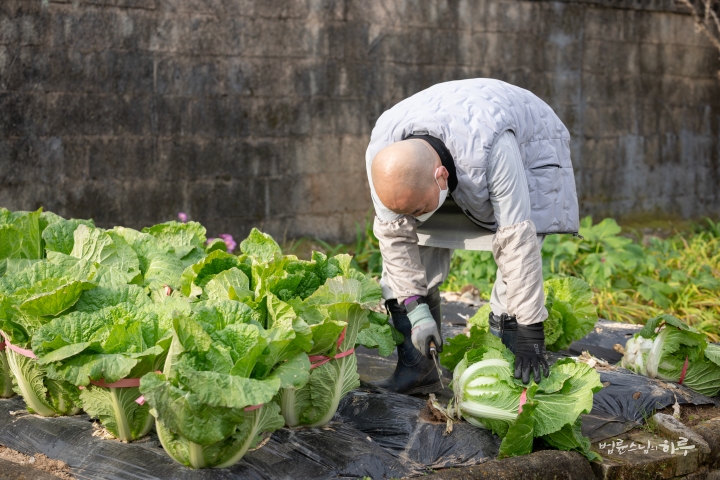

They decided to make more kimchi with the total of 50 cabbages using the leftover seasoning from today’s kimchi-making, and finished all the work.
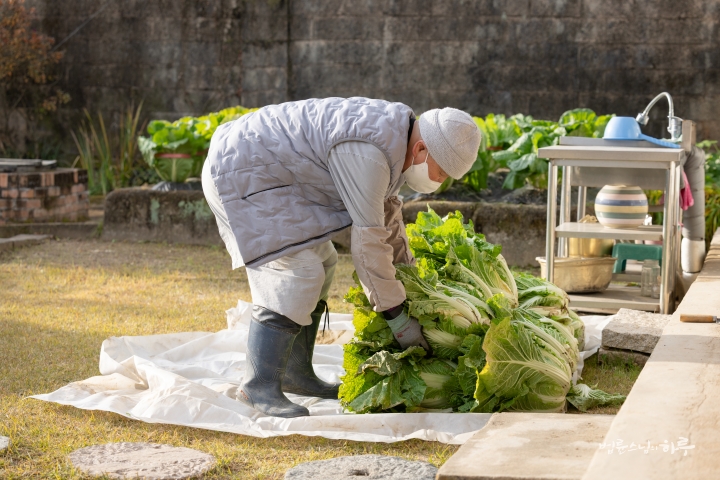
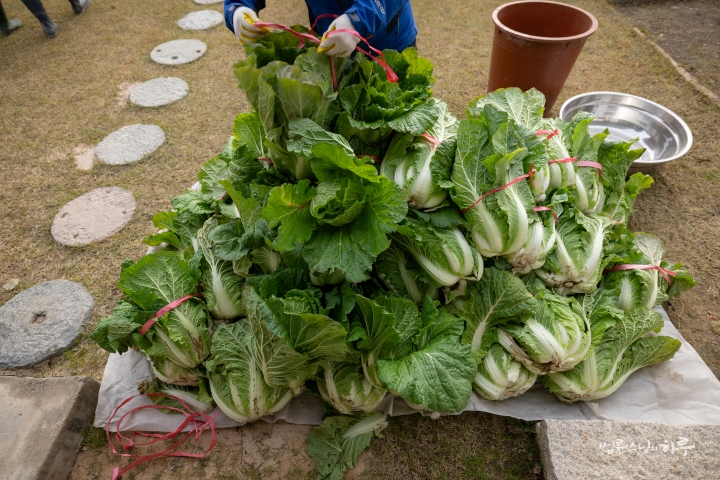
Meanwhile, some practitioners went to the greenhouse to harvest peppers. The farming team urgently requested help as the peppers would all spoil once the temperature drops below freezing, so they needed to harvest them as quickly as possible. About 10 people went to the greenhouse to help with the pepper harvest.

After finishing the cleanup of the warehouse where kimchi-making took place, all work was completed at 9:30 AM.
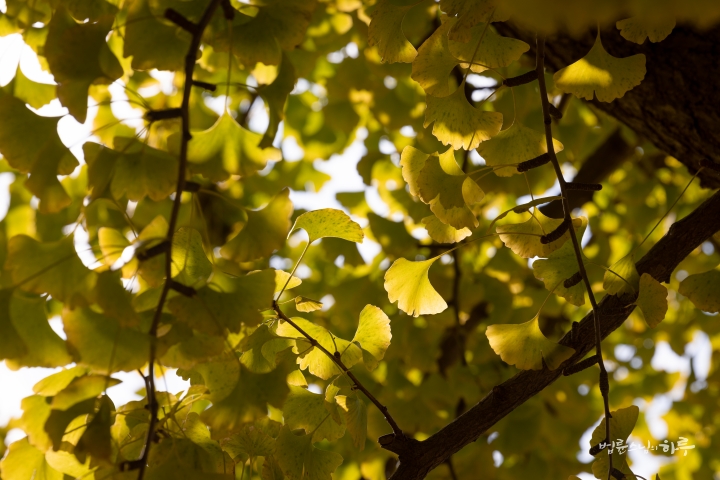
After a quick wash, at 10 AM, they departed with Sunim for a community fall outing to Namsan Mountain in Gyeongju.

In the first half of this year, they couldn’t go on a community outing due to the 100-Day Dharma Talk. In the second half, they couldn’t go either due to Sunim’s continuous overseas schedule, but after finishing the kimchi-making work, they decided to take one more day for a community outing.

Everyone got off in front of King Gyeongae’s tomb and decided to walk the Gyeongju Namsan trail. After everyone put on their transceivers, Sunim began the tour.

“Since there are people like me who can’t climb mountains due to leg pain, we’ll walk the flat trail around Gyeongju Namsan. Starting from here, we’ll pass Sambulsa Temple and Poseokjeong, and there’s a mountain pass that leads to the eastern side of Gyeongju Namsan. Once we climb the pass, there’s a gently sloping hiking trail in the mountains. Let’s walk slowly.”
Upon entering the pine forest, King Gyeongae’s tomb appeared. Stopping briefly, Sunim explained.
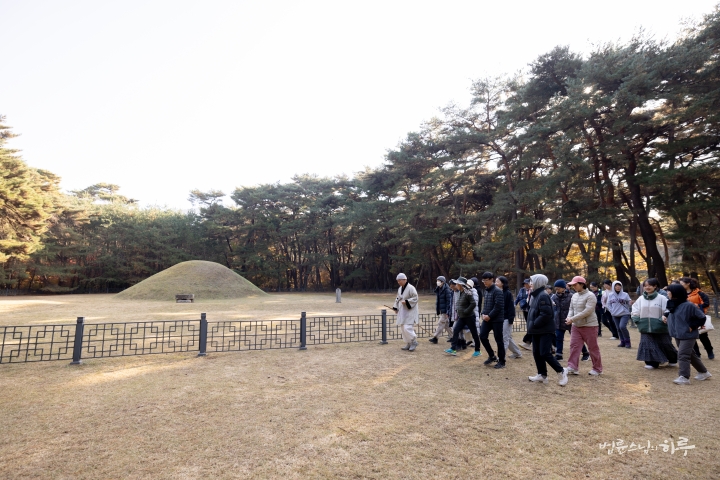
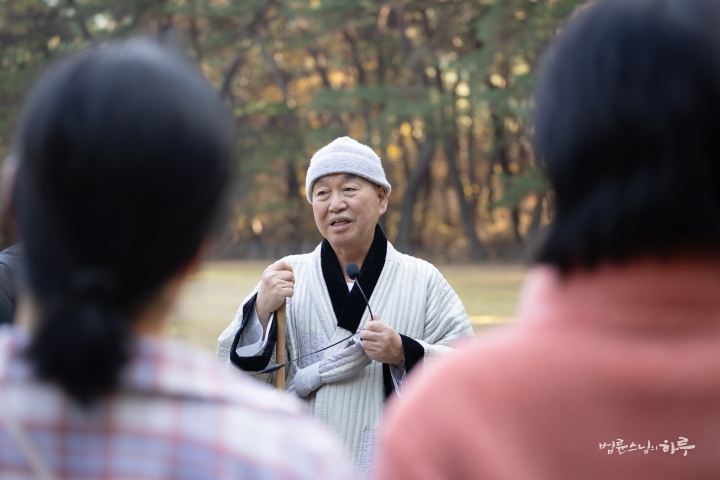
“King Gyeongae was killed by Gyeon Hwon at the end of the Silla period. It’s known that he was attacked and killed by Gyeon Hwon while drinking and playing at Poseokjeong.
This is also a suitable place for outdoor Dharma assemblies as it can accommodate the largest gathering of people on Gyeongju Namsan. Before the fence was built, up to 1,000 people could sit and hold gatherings here. Now with the fence, about 500 people can sit. The space is very spacious.”
Going deeper into the pine forest, Samneung (Three Royal Tombs) appeared. These three royal tombs are said to be the tombs of three Park clan kings: the 8th King Adalla, the 53rd King Sindeok, and the 54th King Gyeongmyeong. However, questions have been raised about the authenticity of the tombs as there is over 800 years difference between the early King Adalla and the other kings.
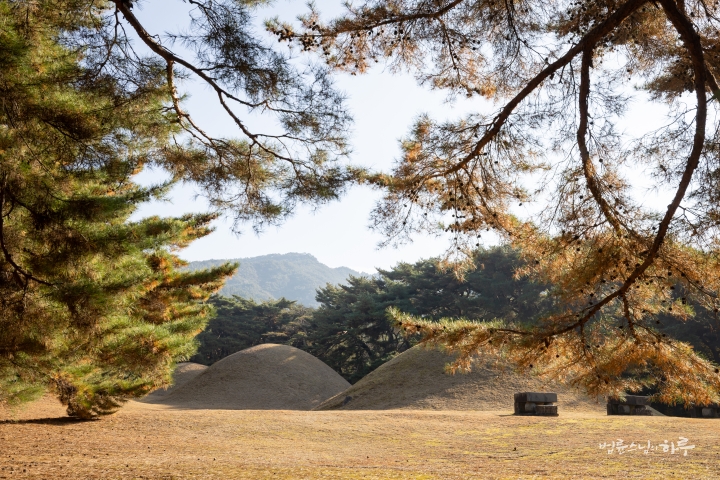
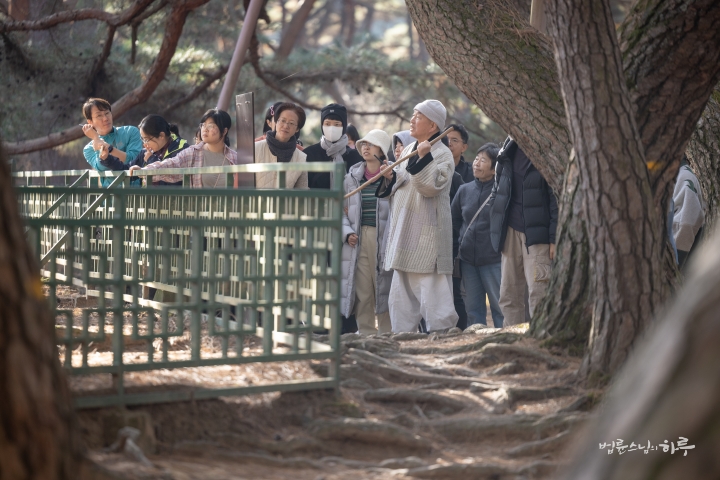
“The original name of this valley starting from Samneung is Naenggol (Cold Valley). Now it’s called ‘Samneung Valley.’ It’s the valley with the most relics on Gyeongju Namsan. As we climb the mountain, we can see many artifacts including the headless Buddha statue that embodies Jungto Society’s founding spirit, Avalokitesvara Bodhisattva, the Six Buddhas in relief, and the rock-carved Buddha with beautiful lips.
Namsan has two axes: North Namsan centered on Geumobong Peak, and South Namsan centered on Gowibong Peak, with Yongjang Valley flowing between them. There are about 60 large and small valleys, and including temple sites, Buddha statues, pagoda sites, pagodas, royal tombs, Sangsabawi Rock, Owl Rock, and other folk artifacts, there are about 700 artifacts in total. That’s why it’s also called an open-air museum. Cheonryongsa Temple site, located in the south of South Namsan, is recorded in the Samguk Yusa as ‘if this temple falls, the country will fall; if this temple prospers, the country will prosper.’ Jungto Society is conducting restoration work here to practice the teachings of Master Yongseong.”
Above all, the winding pine forest harmonizing with Samneung was magnificent.
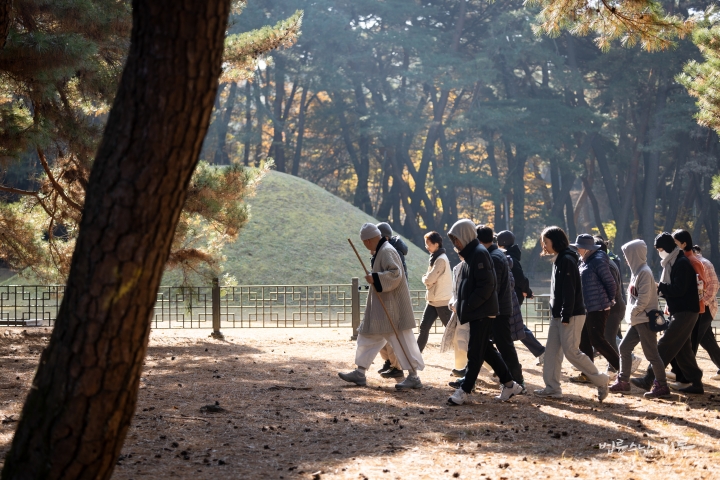
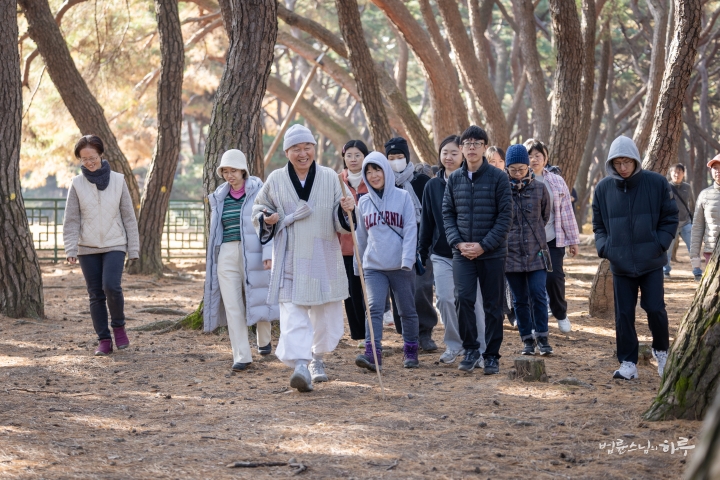
Continuing along the trail leading to the western side of Gyeongju Namsan, Mangwolsa Temple appeared. After making three bows in front of the main gate, Sunim talked about his connection with Mangwolsa Temple.


“When I was young and actively engaged in youth propagation activities while leading the Yeongnam Buddhist Student Association, I stayed at this temple and operated the Yeongnam Buddhist Education Center. This temple is the headquarters of the Wonhyo Order.”
Past Mangwolsa Temple, Sambulsa Temple appeared. Next to Sambulsa Temple, three stone Buddhas were enshrined side by side. The deeply colored autumn leaves embroidered the path to see the Three Buddha statues.
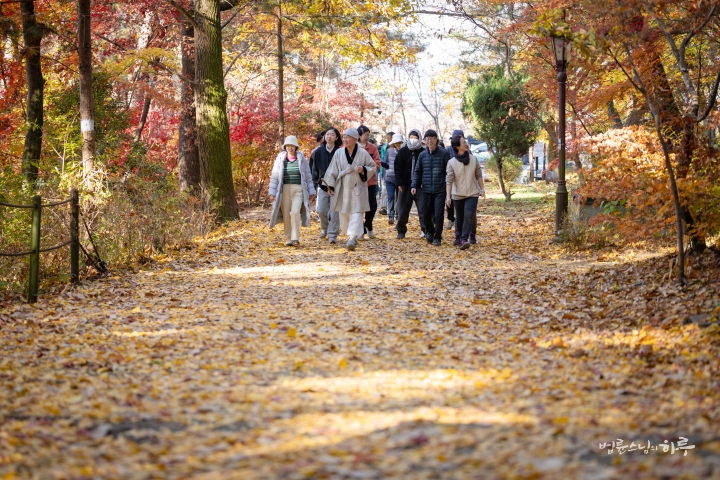
Seeing the yellow and red autumn leaves, everyone exclaimed and took out their phone cameras.
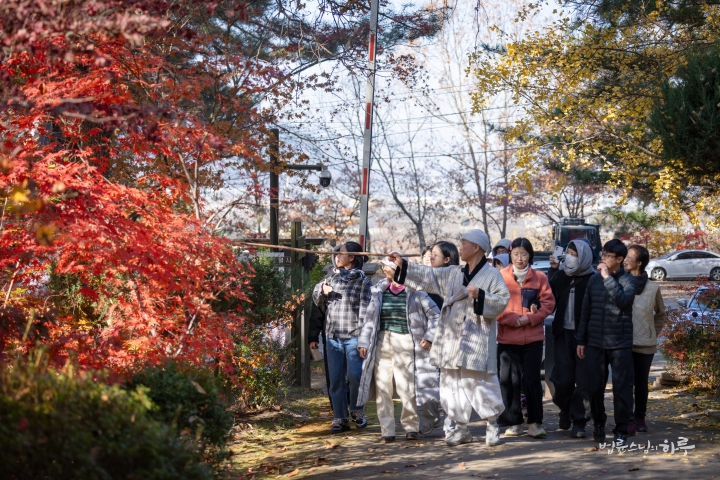
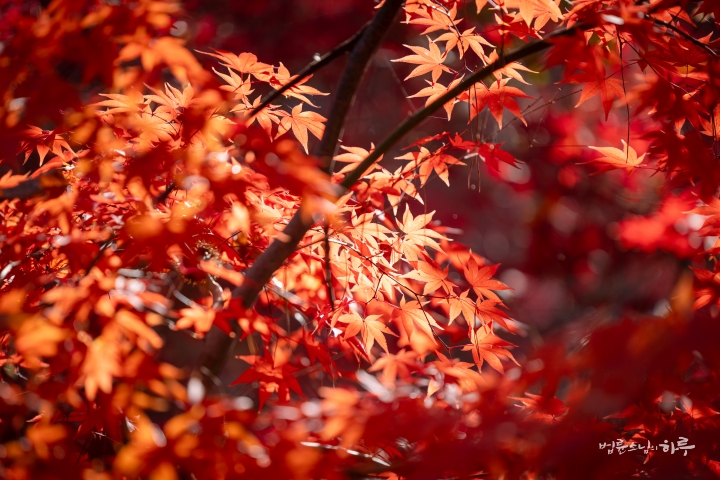
Standing in front of the Three Buddha statues, they joined their palms and made three standing bows. All three statues looked like cheerful and innocent babies.
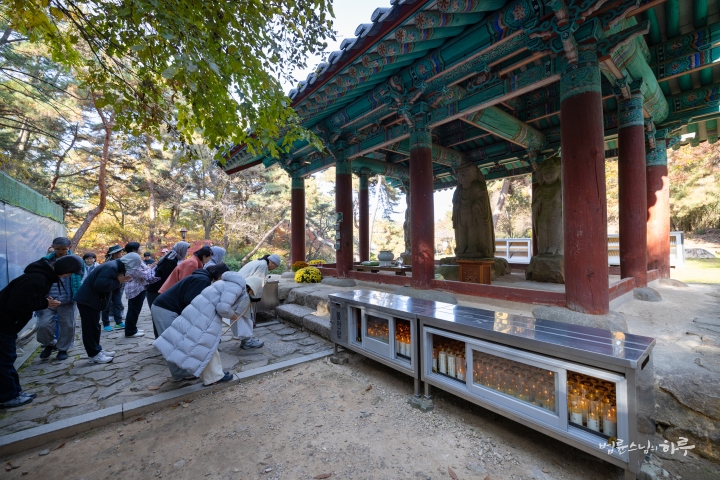
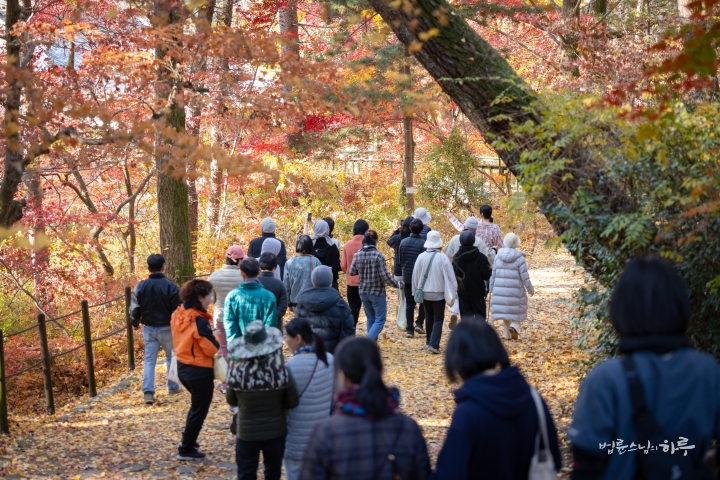
After circumambulating and paying respects to the Three Buddha statues, they walked out into the forest thick with maple trees.
“Let’s take a photo with the maple trees as the background.”
After taking a commemorative photo at Sunim’s suggestion, they continued walking the trail.
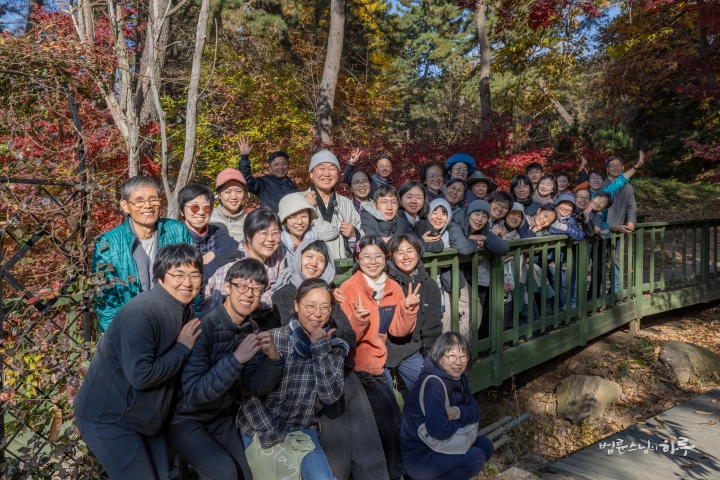

Past Sambulsa Temple, a small pond called ‘Taejinji’ appeared. It’s an ecological park where various aquatic plants show off their beauty each season. The sky, mountains, and trees harmonized with the pond to create a serene landscape.
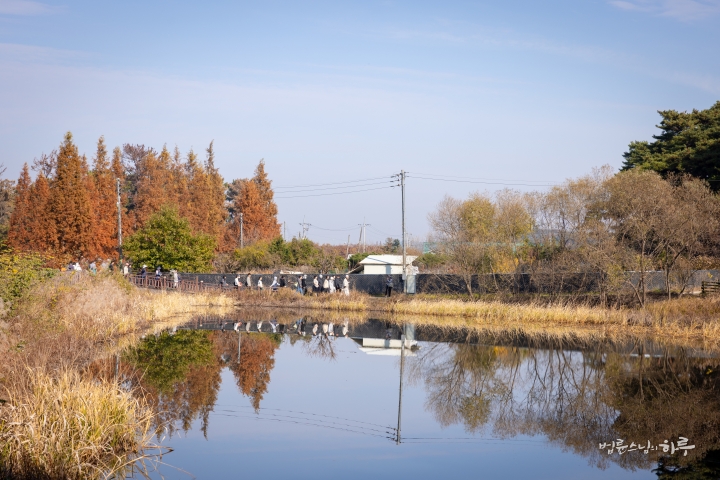

Passing King Jima’s tomb, they arrived at Poseokjeong. After passing through Poseokjeong surrounded by lush ginkgo trees, they entered an alley. Interesting paintings were drawn on every wall. The colorful colors brightened their hearts.
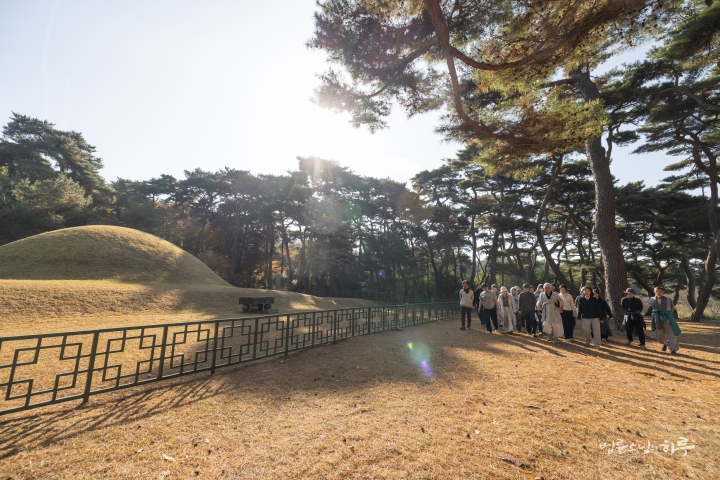
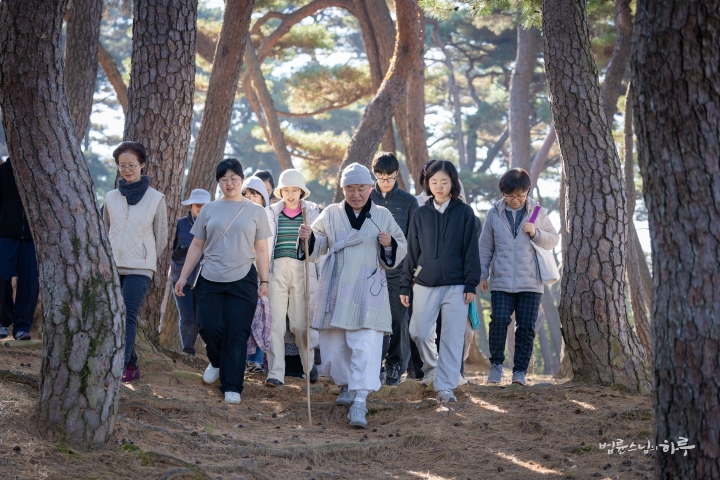

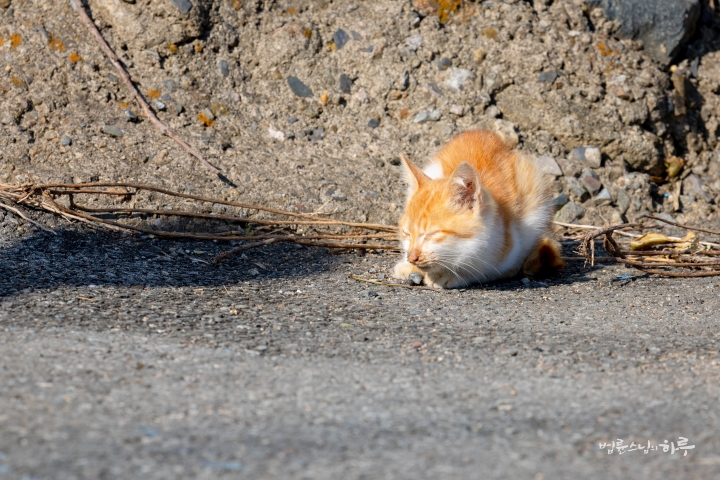
Leaving the alley, the three-story stone pagoda at Changrimsa Temple site could be seen in the distance. It’s the largest stone pagoda on Namsan. Sunim pointed to the pagoda with his walking stick and explained.

“The place where you can see the stone pagoda is Changrimsa Temple site. Changrimsa Temple site is known as the location of Silla’s first palace. If we go a little further from here, we’ll come to ‘Najeong,’ a well that holds the legend of Park Hyeokgeose’s birth. You can see the forest in the distance – that’s Najeong.”
They continued walking. Around them spread fields where the harvest had been completed.
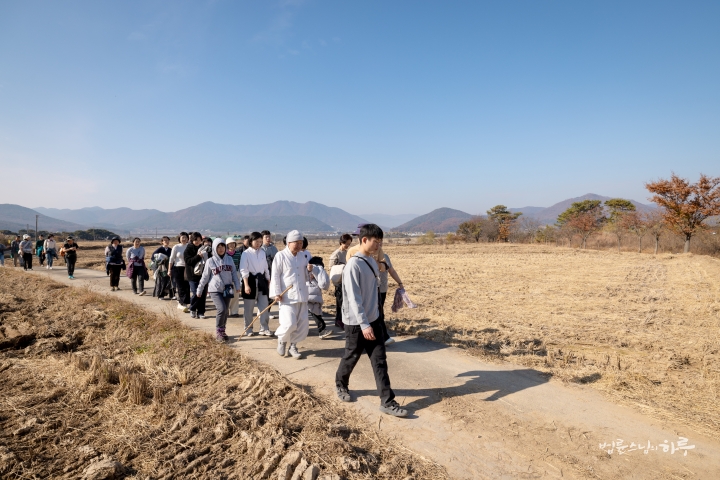
Shortly after, they arrived at the Namgansaji Temple Flagpole Support.
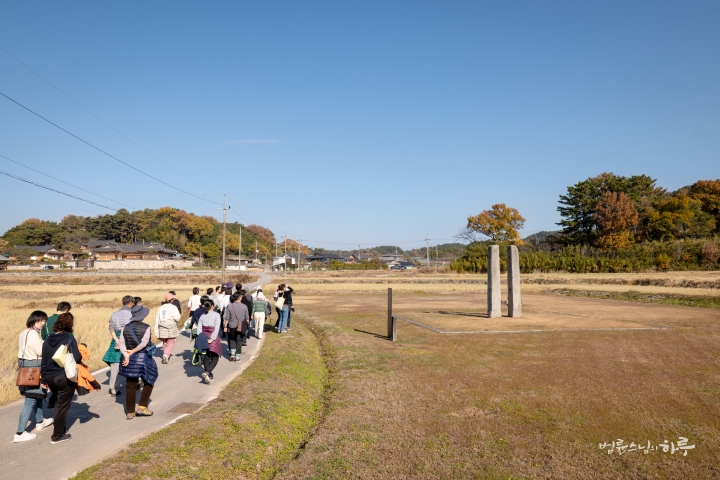
“The flagpole support is known as a structure erected to hang large flags symbolizing the temple. In some temples, a pair of flagpole supports remain, and in these cases, they were reportedly used as devices to hang large Buddhist paintings (gwaebul) during major temple events. Looking at the stone pillars on both sides that support the flagpole, you can see small holes, which were devices made to firmly secure the flagpole. During major ceremonies or Dharma assemblies, enormous Buddhist paintings would be hung here.”
Standing in front of the flagpole support and looking around, Sunim could somewhat sense how large this temple must have been in ancient times.
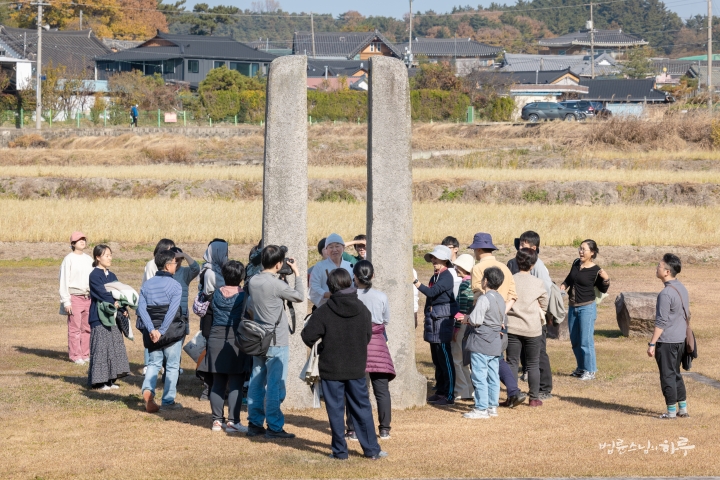
After passing the flagpole support, Namgan Village appeared. Within Namgan Village, there remained a stone well presumed to be from the old site of Namgansa Temple. It was constructed by digging into the ground, stacking stones, and then placing a stone frame on top.
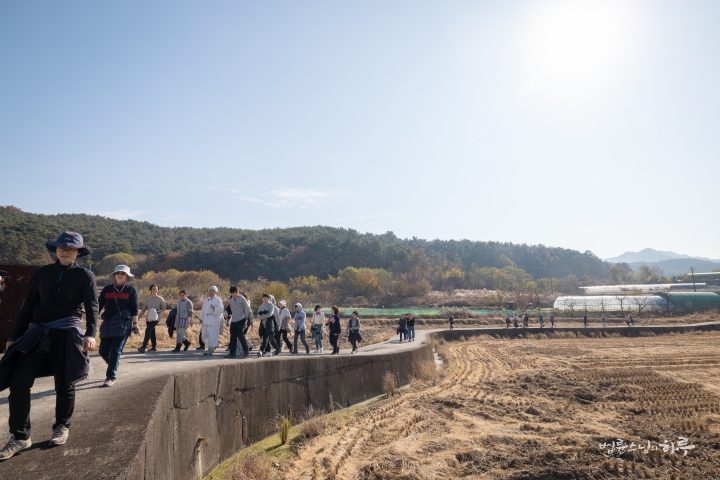
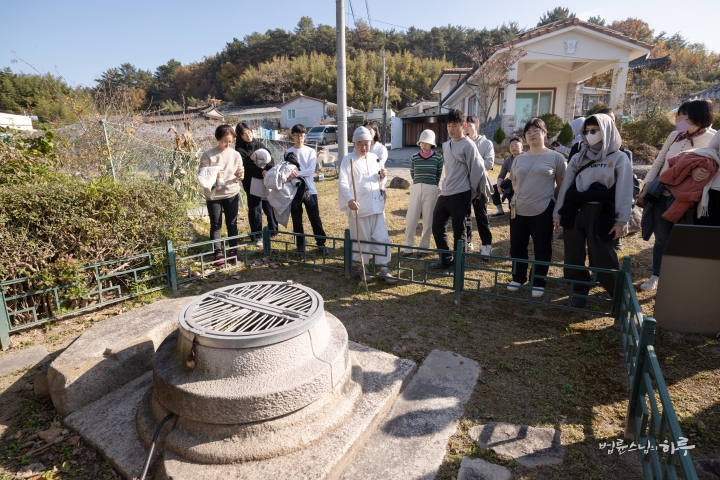
“This stone well (seokjeong) remains intact from when it was made during the Silla period. Here, the well shape is entirely circular, but the stone well at Bunhwangsa Temple is quite different in shape. The exterior of the well frame is octagonal, the interior is circular, and the inside of the well is square. These represent the Eightfold Path, the One Circle philosophy, and the Four Noble Truths, respectively.”
Everyone marveled at how the intricate carvings remained intact.
As they were leaving Namgan Village, they came upon the historic residence of General Kim Ho. Since General Kim Ho was said to be the first to raise a volunteer army during the Japanese invasions of Korea, the residence’s history is estimated to be over 400 years old. It is said to be one of the oldest remaining private buildings in Korea. Since descendants still live there, they only viewed the exterior before continuing on their way. After passing the historic residence, the hiking trail starting from the northernmost point of Namsan Mountain in Gyeongju appeared.

“From here, we’ll be entering the mountain, so it will be shaded. Let’s rest briefly in the shade before continuing.”
After drinking water and catching their breath, they began walking the mountain path.
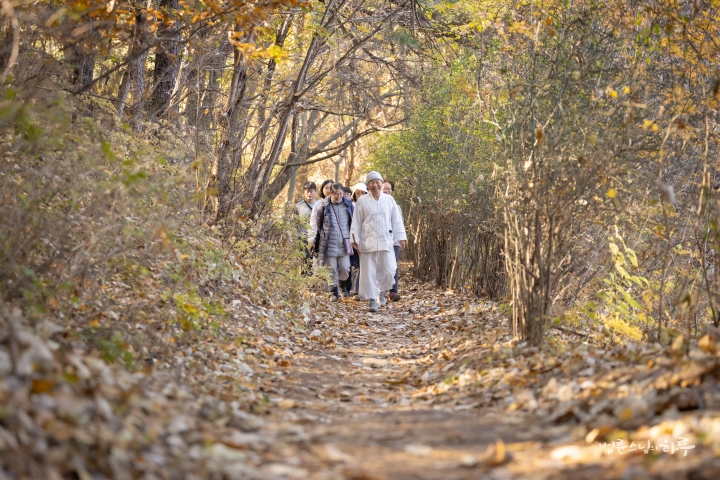
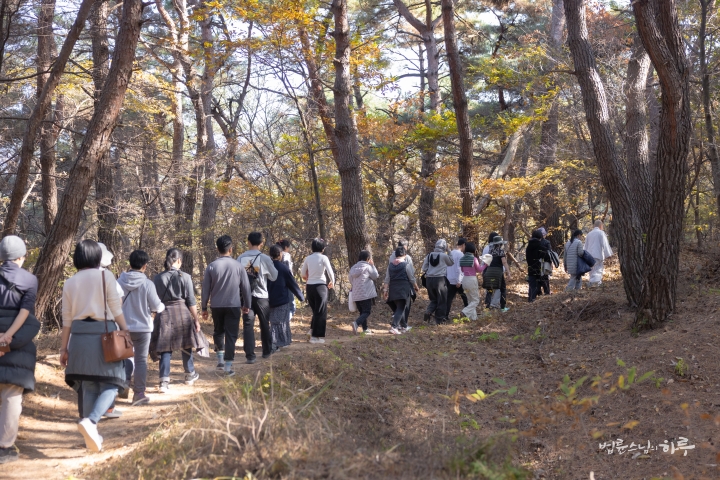
“Although it’s a hiking trail, it’s almost as flat as level ground. It’s very pleasant for walking. Let’s walk while savoring autumn.”
From this point, Sunim also stopped explaining and quietly walked the mountain path, savoring the autumn atmosphere. The leaves bathed in sunlight sparkled like fluorescent lights, radiating light.
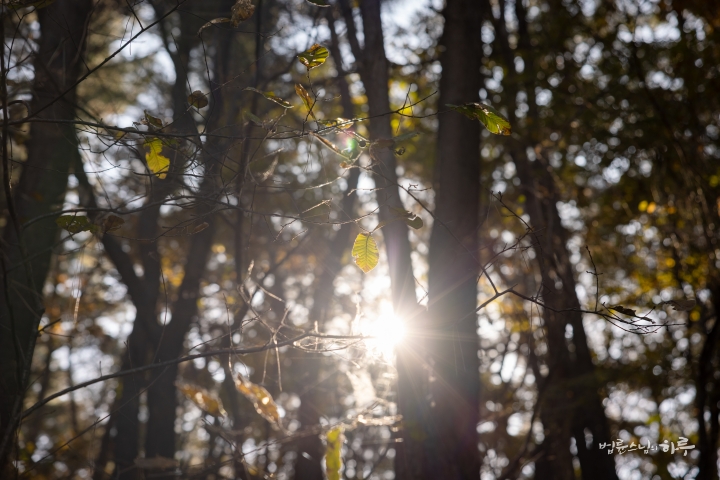
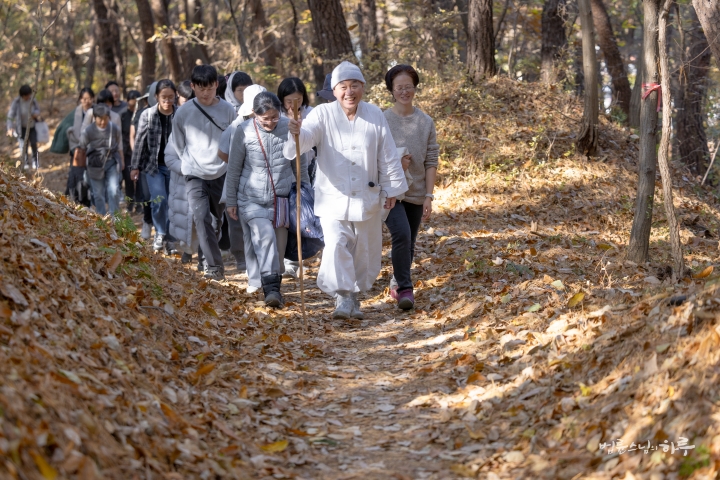
After walking the mountain path for a while, they began descending just as the uphill climb was about to begin in earnest.

After descending the mountain path a bit, a hidden Buddha revealed itself among the rocks bathed in warm sunlight.

The Buddha, carefully carved from hard granite in a small niche where it would have been difficult to properly swing a hammer, had a truly friendly and warm face. Together, they looked at the Buddha statue and recited the Three Refuges and the Heart Sutra.
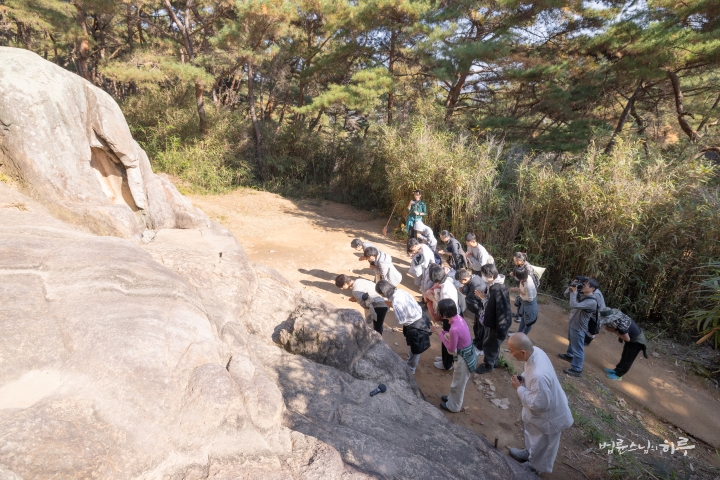
Sunim then explained while looking at the Buddha statue.
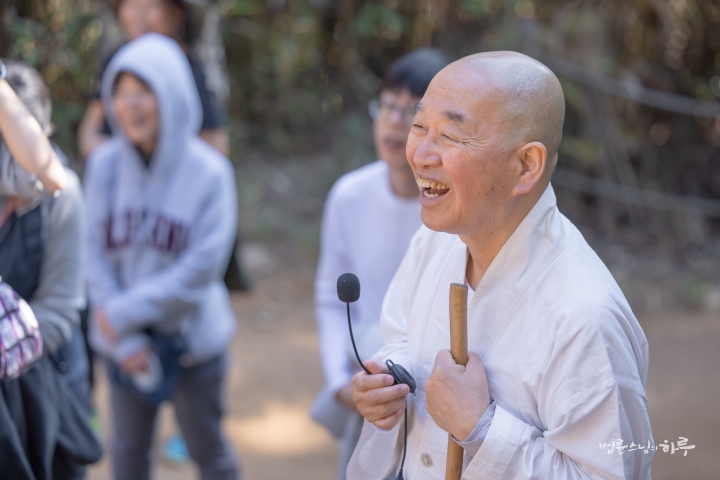

“If you look at this Buddha statue, you can see that a cave was carved into the rock to create a niche where the Buddha statue was enshrined. The figure wears a crown on its head, and with hands clasped in front, the Buddha’s face is said to resemble a grandmother deity, which is why people also call it ‘Grandmother Buddha.’ It has a very friendly feeling and faces directly south. Let’s take a commemorative photo since we’ve come this far.”
After taking a group photo together, they descended the mountain.
“Go, community!”
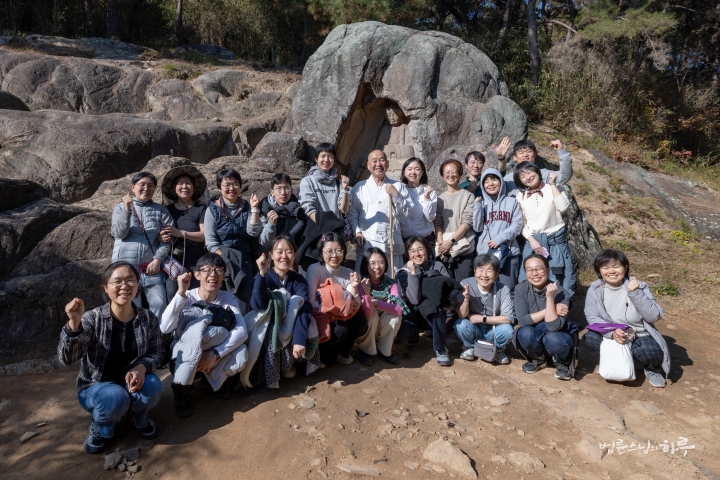
Upon descending, they found that two hours had passed since they began their walk. They had walked 13,000 steps. Sunim said with a smile.
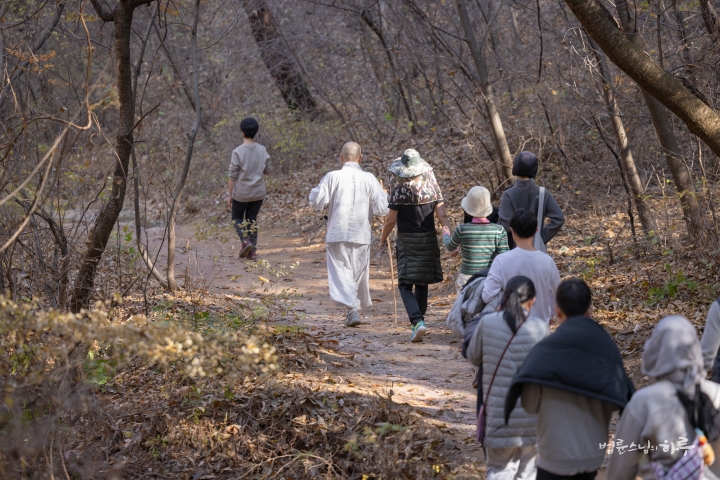
“If I walked like this every day, my body would become healthy. Did you all enjoy it too?”
“Yes!”
“Then I hope you all have a safe journey back. Please enjoy something delicious at the rest stop on your way up. Thank you for your hard work over these three nights and four days.”
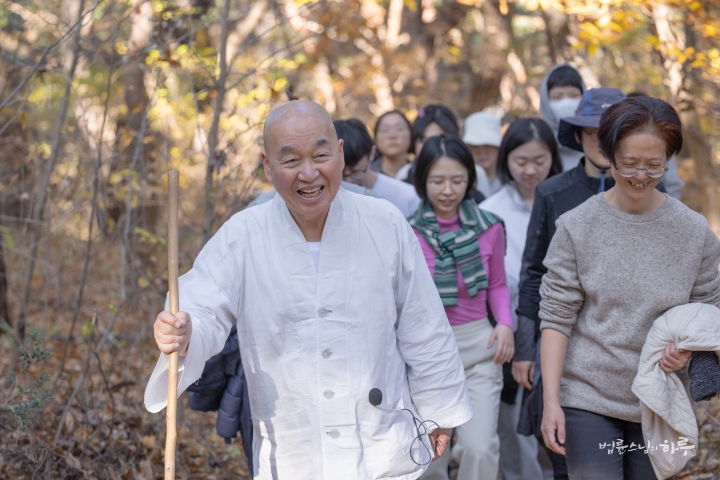
After exchanging farewells with the community members, Sunim returned to Dubuk Jungto Retreat Center and had lunch.
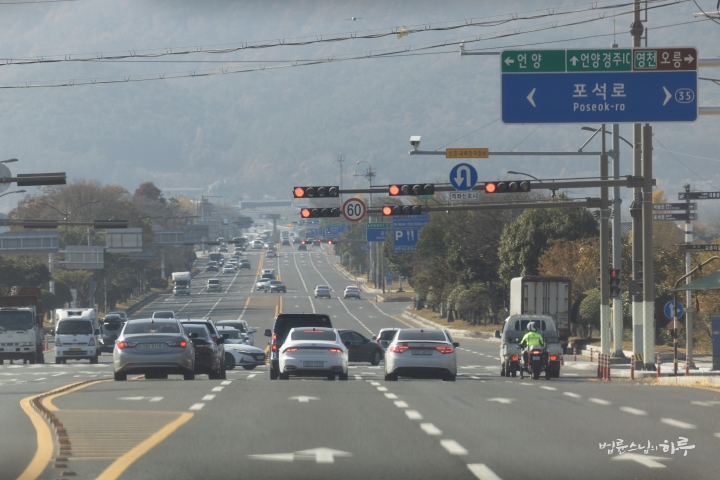
After lunch, Sunim helped with making kimchi from the remaining 50 heads of cabbage in the afternoon, then departed from Dubuk Jungto Retreat Center at 4 PM heading for Busan.
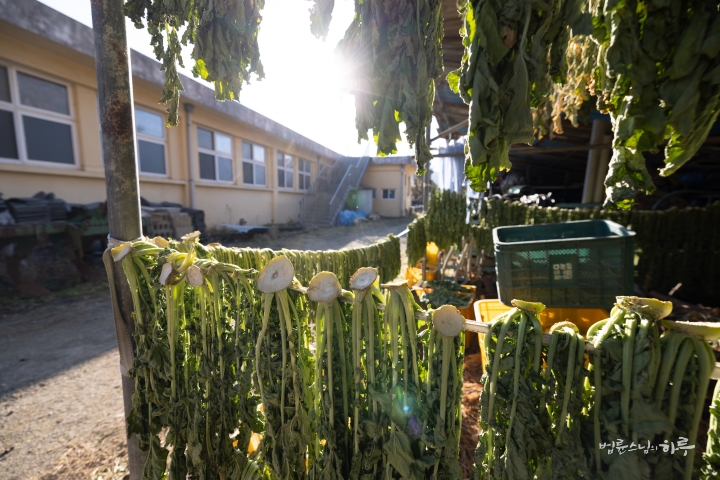
Today was the day of the ninth Happy Dialogue Dharma Q&A lecture in Busan. After driving for an hour and a half, Sunim arrived at the lecture venue entrance at 5:30 PM.
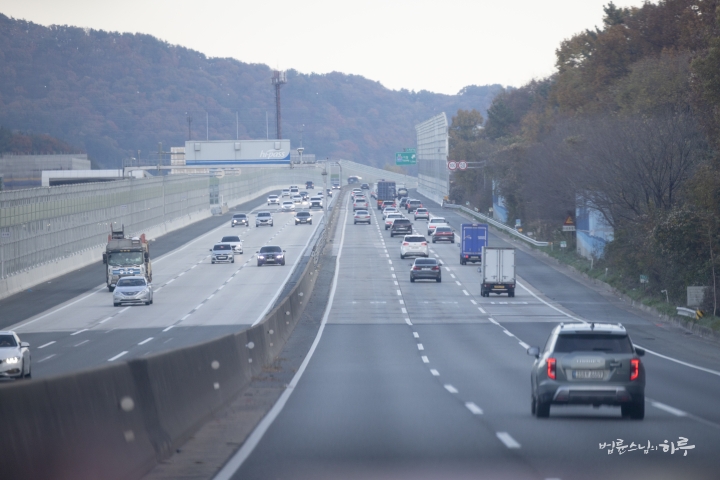
Today’s lecture was held at the University Theater of Pukyong National University in Nam-gu, Busan. When Sunim arrived, many citizens were already lined up waiting to enter, even though it was still two hours before the lecture.


“Hello. So many of you have come.”
After greeting the citizens, Sunim entered the University Theater. There was a local dignitary who had requested a tea meeting in advance, so Sunim had a brief conversation with them.
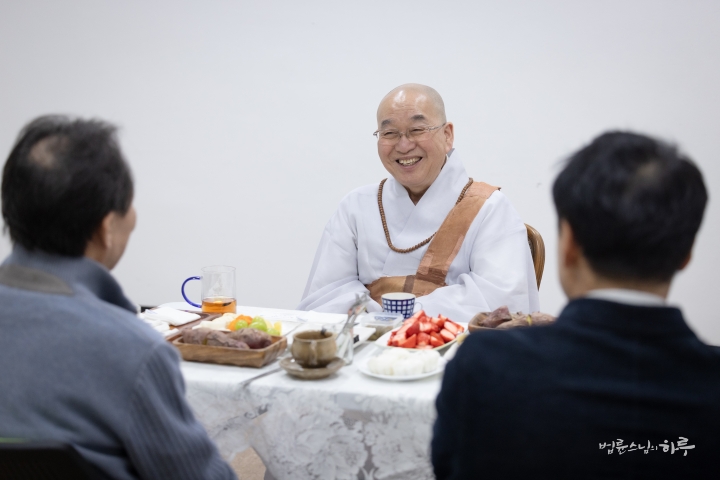
Subsequently, several people including Professor Shin Bo-seong from Pusan National University and Professor Park Young-hwan from Pukyong National University, who had helped secure the lecture venue, came to have tea with Sunim. The professors all expressed concern for Sunim’s health.
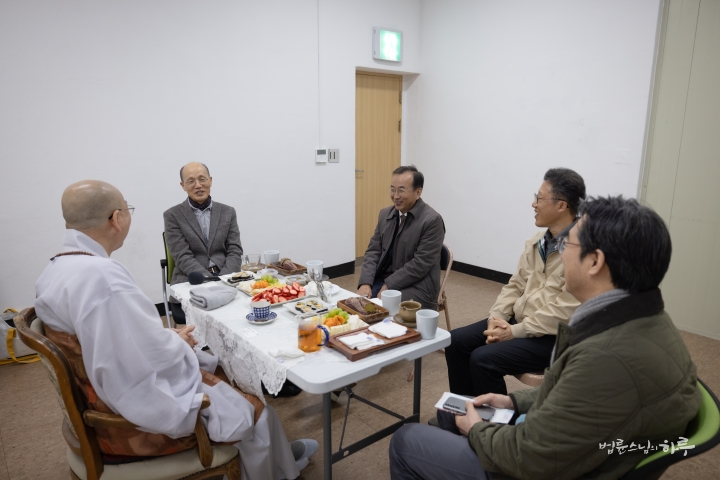
“Looking at your schedule, Sunim, you have many overseas trips and it’s really packed, so you must be very tired. Is your health okay?”
Sunim shared his observations from traveling abroad.
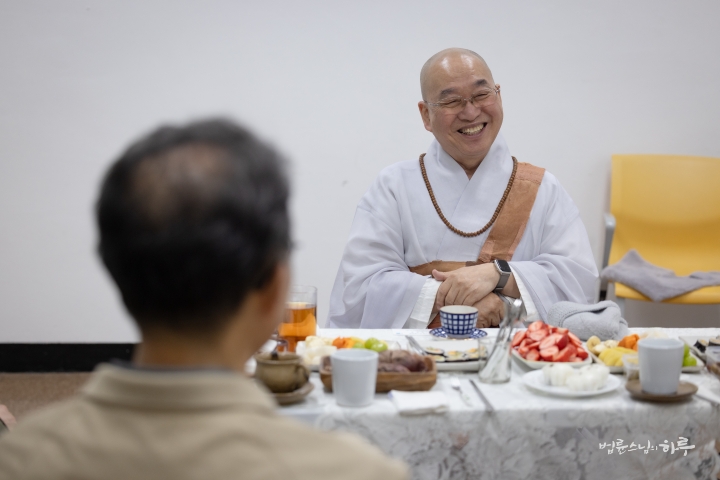
“Although it’s tiring, I learn a lot. What I’ve realized from traveling abroad is that the biggest problem our country faces is the danger of war due to division. And the second problem is that the technical workforce supporting the nation’s key industries is gradually disappearing.”
Workplaces with Only White-Haired Technicians, What We Need to Prepare for the Future
“While skilled technicians still remain among those in their 60s, when you go down to those under 40, the technical workforce is almost at the point of extinction. Just as the United States is struggling due to a lack of technicians to work in shipyards, our country might also face a shortage of workers in just 10 years. Wherever you go, young generations should be working alongside others in labor sites, but they’re filled only with gray-haired middle-aged and older workers. In the past, when I went to give lectures at Daewoo Shipyard, there were many young technicians, but now almost everyone has white hair. These days, young people want to be baristas making coffee in cafes, but they avoid technical labor jobs that require physical work. Young people complain about difficulty finding employment, while on the other hand, small and medium-sized business representatives cry out about not being able to find workers. As a result, advanced technical skills are increasingly being transferred to foreign workers. This is because the higher the education level, the more people avoid technical jobs.”
“That’s why I often think, ‘Shouldn’t the nation actively operate two-year technical colleges or technical education platforms that can systematically train technical personnel, becoming a global supplier of technical workforce?’ Also, by managing core technical workers who support national key industries at the national level, we could prevent the crisis that the United States is experiencing by being prepared for emergencies. Right now, the United States says that even if they build factories, there are no people with advanced skills to work in them.”
The professors strongly agreed with Sunim’s thoughts.

“You’re right, Sunim. When we graduate students here in Busan, small and medium-sized enterprises post many job openings saying they need workers, but students don’t submit job applications. They all prefer stable jobs like large corporations, public corporations, public organizations, or civil service positions. The low social status of technical workers also seems to be a cause.”
Sunim emphasized the need for the government to establish policies.

“It seems our country is not yet paying sufficient attention to filling these social gaps and building social safety nets. For example, there needs to be a system that allows technical workers to grow stably, such as guaranteeing their status if technical personnel working in small and medium-sized enterprises register with the government, or having the government support a certain portion of wages. I think that only with such policy support will it be possible to train and maintain technical personnel in small and medium-sized enterprises.”
As they conversed, it was time to begin the lecture.
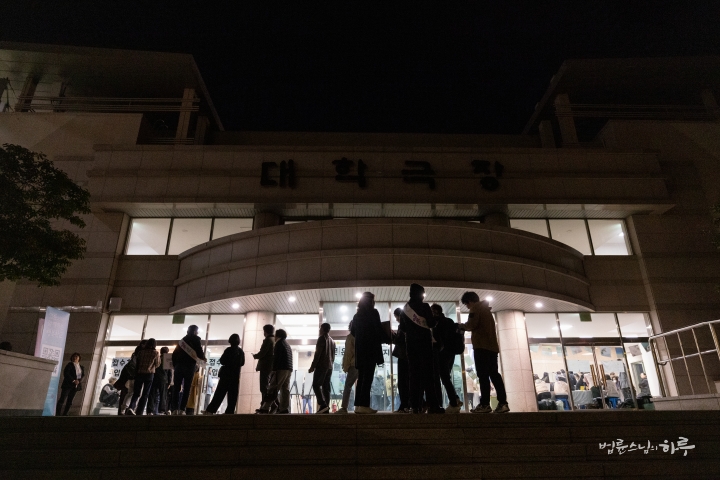
At 7:30 PM, the lecture began with the energetic voice of BTN Busan’s announcer Kim Ji-won.
“Now let’s begin Happy Dialogue with Venerable Pomnyun Sunim!”

As a pre-performance, the Echo Sound Group, which performs busking in the Busan area, sang exciting songs. When they passionately sang two songs, “Trust Only Me Now” and “Let’s Go on a Trip,” everyone applauded enthusiastically.
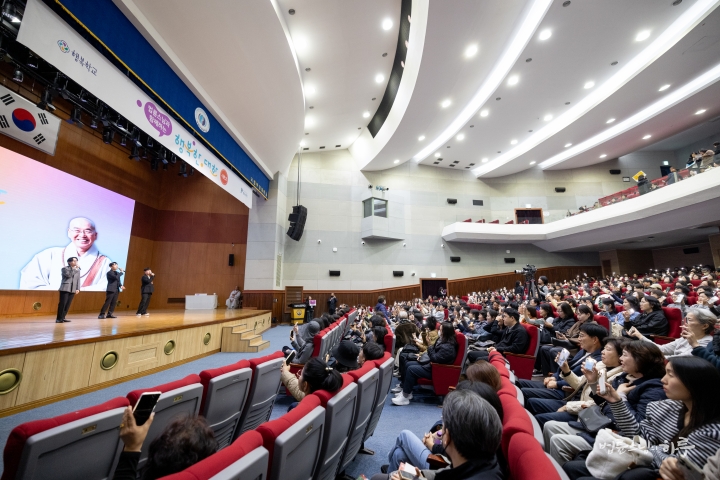

It was a wonderful stage created by three men from Busan. Sunim shook hands with the Echo Sound Group who performed as a talent donation, expressed his gratitude, and took a commemorative photo together.

After watching an introductory video about Sunim together, he walked onto the stage to great applause. The lecture hall was packed with about 700 people. About 5,000 people connected to the YouTube live broadcast. First, Sunim greeted the Busan citizens whom he hadn’t seen in a while.
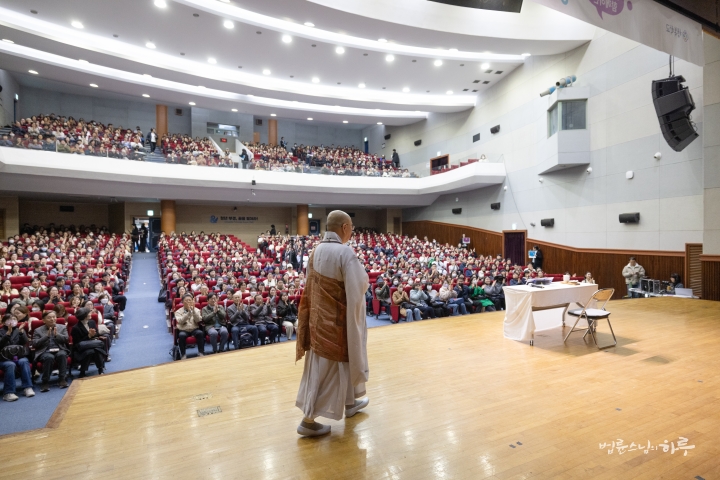
“Nice to meet you. It’s been a while since I’ve come to greet you in Busan. The weather suddenly turned cold and I thought winter had come, but it’s warmed up a bit again. I spent the last three days – Friday, Saturday, and Sunday – making kimchi. About 100 members of our community live together at the temple. So every year we need to make kimchi for the whole year, and this time too we harvested 1,000 heads of cabbage and made quite a commotion for three days making kimchi. We pulled up the cabbage to wilt it, then stuffed and seasoned it, and packaged it. We also gave some as gifts to several people. And to repay the community members for their hard work with the kimchi-making, today we walked the Gyeongju Namsan trail for about two hours and enjoyed autumn, even though it’s late autumn. Did you all go out to the suburbs this weekend? City people all live trapped in apartments these days, don’t they? Thank you for your hard work living in prison.” (Laughter)
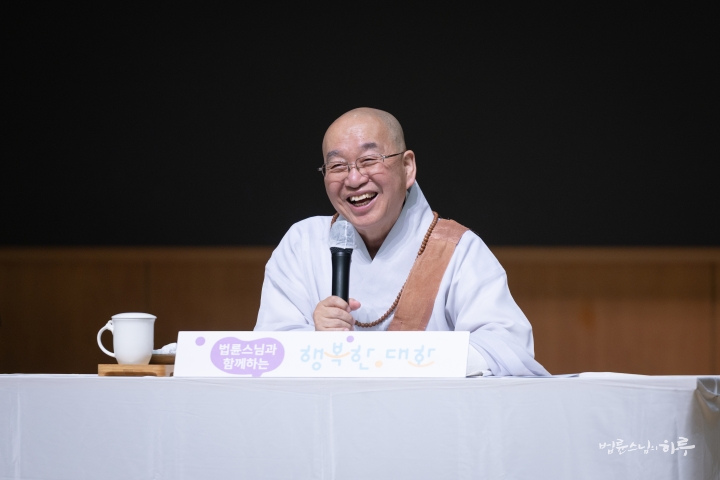
Then anyone could raise their hand and ask Sunim questions. First, five people who had signed up for questions in advance at the entrance asked questions, and on-site questions were also taken. Over two hours, seven people shared their concerns and had conversations with Sunim. One of them was worried about becoming a stepmother to two teenage daughters, as she was marrying for the first time while her partner was remarrying, and asked Sunim for advice.

This Is My First Marriage, My Partner Is Remarrying with Two Daughters, and I’m Worried About Becoming a Stepmother
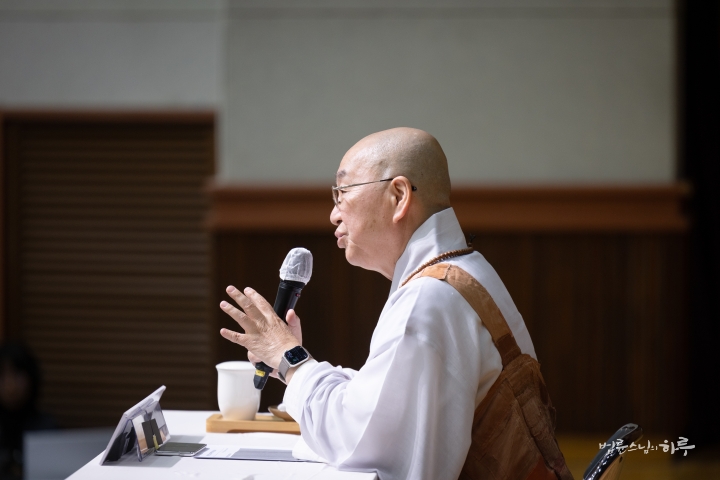
“While you may think your situation is special, in places like the United States, this could be considered a typical family situation. One person having children and the other not is just one of many forms of marriage – it’s nothing special. You feel it’s special because you think marriage is something that happens between two people who are both marrying for the first time. As I travel around the world, I see that situations like yours are just one ordinary form of relationship. There’s no need to think of it as special.”
“I’m concerned that the children seem to be getting hurt in the process of our relationship.”
“While it may be good for the two of you, from the children’s perspective, it’s naturally hurtful. From a young child’s point of view, it’s difficult to easily understand a situation where parents fight and separate. That’s why divorce inevitably leaves scars on children. You shouldn’t think ‘I won’t hurt the child.’ Your relationship itself is hurtful to the children, so thinking you won’t hurt them is wrong. You should think about ways to minimize the hurt. From the child’s perspective, they have a biological mother, and now another woman comes and also calls herself mother – that’s hurtful. If this had happened to you when you were young, would you have been able to accept it easily? If you accept that it’s natural for children to be hurt, the problem becomes less severe. The problem arises when you try not to hurt them at all. That’s simply not possible.”
“Then what mindset should I have?”

“You don’t need to think that you shouldn’t get married because of this reason. If the two of you want to get married, you can get married even if it causes some hurt to the children. From the children’s perspective, they might refuse to accept a stepmother even if their biological mother has died. However, when the mother has passed away, it’s still easier to accept. The mother has already passed away, and they also need someone to fill the mother’s role. While they may reject the stepmother, they know they need help. But in cases of divorce, even though mom and dad live separately, children want to go back and forth between their mother and father – they don’t want a third party involved. That’s the children’s perspective. That’s why when divorcing, you must ask the children.
‘Mom and Dad don’t get along well and we have these problems, and we’re sorry to you. But is it better to live like this, fighting every day? Or would it be better to live separately? You can freely visit both Mom and Dad, but it’s really difficult for Mom and Dad to live in the same house – what do you think?’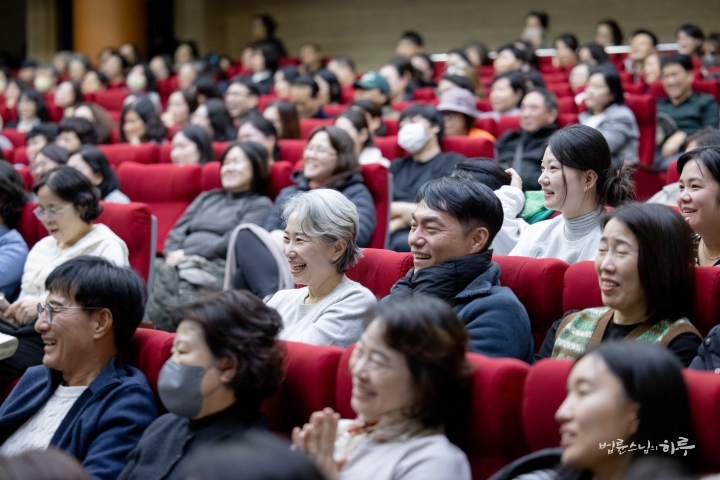
This is how you need to seek the children’s understanding. However, once the children become adults, there’s no need to ask for their opinion. The couple can decide between themselves. But when children are minors, parents must take responsibility. You need to make decisions with full consideration of the children’s opinions. You should either live separately or adjust your relationship while living in the same house and conclude to live together for the children’s sake. But the fact that you divorced means you didn’t consider the children much. You focused on the marital conflict and gave less consideration to the children. The children have already been hurt, and it’s natural that they’ll be hurt more if a stepmother comes into the picture. It has nothing to do with the stepmother’s behavior. You either need to take the perspective that you must live together even if it causes some hurt to the children, or if you think you shouldn’t hurt the children, then you shouldn’t remarry.
You can just remain friends with each other. Do you really have to get married? These days, many people live together without getting married if they’re happy together. In Western countries, don’t more than 50% of couples live together without marriage? When people with their own children become a couple and live together, conflicts often arise when the remarried husband or wife treats their partner’s children somewhat coldly. A Western person I know found a two-story house where the wife lives upstairs with her children, and the husband lives downstairs with his children. They live as separate families while still living in the same house – this is one way to resolve conflicts. There are various methods. So first, it would be good for the father to have a conversation with the children. 
‘Mom and Dad are already divorced, and Dad needs to live with this woman. We’re worried that you might get hurt. What should we do? Would you like to live together in harmony even if it’s uncomfortable? Or is it too uncomfortable, so would you rather go to Mom?’
Asking the children this way doesn’t mean leaving the decision about the couple’s marriage to the children. If two people like each other, they can get married. It simply means considering the children when deciding how to approach marriage or dating. Even if they get married, they could live in separate houses with the children staying with Dad while you come and go, or they could live together and take care of the children. If the children need it, they can do that, but if the children strongly refuse, it would be difficult. If the children’s refusal is too strong, you can say, ‘If you don’t like it, go live with your mom. We’re going to live together.’ What’s there that can’t be done?”
“Thank you.”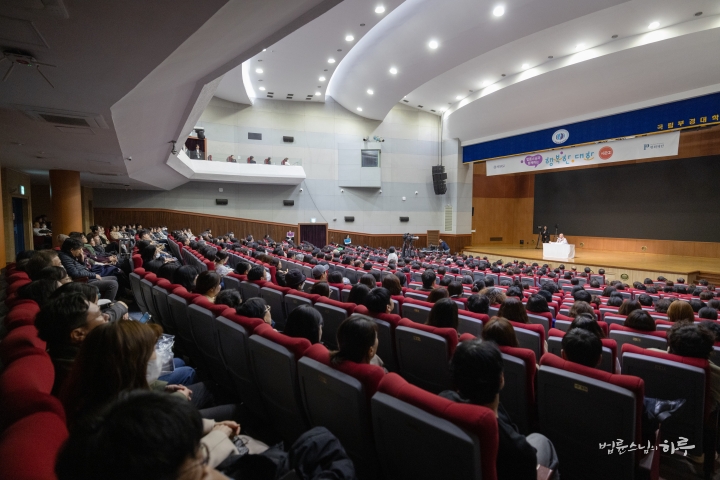
“Marriage and dating are different. Dating only requires two people to have feelings for each other. It’s okay if there’s a big age difference, if they’re foreigners, or if they have children. But marriage is different. Marriage means becoming family members. While two people are getting married, for the child, it means having another mother. The child has the right to oppose a new person joining the family.
The same goes for parents. Sometimes when a son wants to get married, the parents don’t like the woman. Since the daughter-in-law is someone who enters the family, if there are aspects that family members don’t like, they can oppose it. Thinking ‘Why are you opposing our marriage?’ is wrong. Then I need to make a choice. I can withdraw from the family unit, leave home, and get married. Then the relationship with the original family members becomes distant. If I belong to a family unit and want to bring in a new family member, I shouldn’t decide alone. I should ask other members’ opinions, saying, ‘This person wants to become a member of our family. What do you think?’ Even if there’s some opposition, if they agree to try living together as members, then it’s accepted. If the couple absolutely must get married but other members oppose it, there’s no need to resent them. Just say, ‘I understand. Then we’ll get married,’ and withdraw from the family unit. As adults, they can make this decision. All animals become independent from their original family when they reach adulthood and form new family units. Only humans live in such a complicated way.
If you want to live together as family members, you need to get the consent of other members. The children were living as family members before you, right? So you need to ask them, ‘Would it be okay if I lived with you? If I live with you, there are these advantages and these inconveniences. What do you think?’ If the children oppose it, you should say, ‘Then go to your mother. But I’ll provide regular financial support,’ and reorganize the family members. There’s no need to think it’s ethically wrong. How to form the family unit can be decided by the two people in agreement, with the future husband discussing it with his ex-wife. ‘The children oppose the remarriage. How about you raise them? I’ll provide regular child support.’ This is also a way to arrange things. If the husband needs to raise the children, the husband should try to persuade them by saying, ‘I love you, but I need a wife. So please understand.’ In this case, he should say ‘I need a wife,’ not ‘You need a mother.’ You shouldn’t keep making excuses about others. 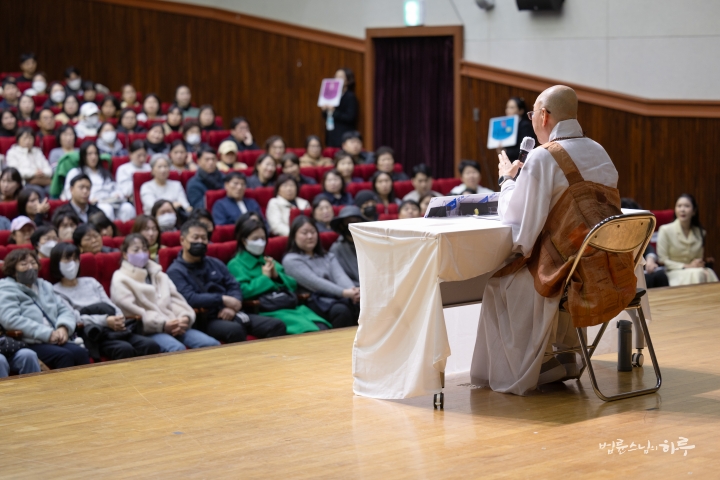
What should you do when living with the children? The children have their biological mother, so if you try to play the mother role, it will confuse them. As a family member, you should help with household chores regardless of whether they’re your biological children or not, but basically, you should avoid interfering in the children’s daily life or studies as much as possible. When your partner says, ‘The kids aren’t studying these days, so you should talk to them,’ you should only offer your opinion and let the father talk directly with the children. If you step in and interfere, conflicts will arise with comments like ‘Is the rolling stone trying to remove the embedded stone?’ If you maintain the perspective of ‘helping but not interfering,’ there won’t be problems living together. Problems always arise from interference. The children don’t need a mother figure, but if you try to play the mother role with excessive meddling, conflicts will occur. Even if they ask you to play the mother role, if you take the stance of ‘Let me think about it first,’ conflicts won’t arise. Having this perspective isn’t that difficult. We can live any kind of life.”
“Thank you. I understand well.”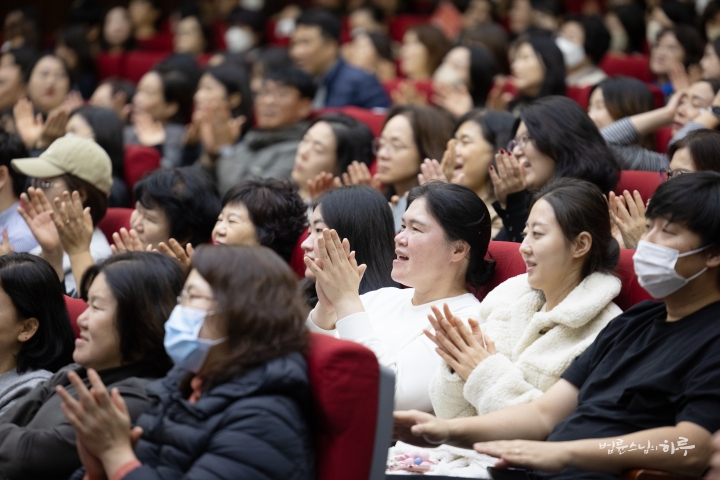
Questions continued one after another.
I’ve lived intensely with an achievement-centered life, but recently I’ve been taking care of my mind and looking back at my anxiety and wounds. Now I want to start something new without impatience. Is it okay to do this?
Every time I start something new, I experience repeated failures due to unexpected external circumstances. I want to start again, but I’m afraid the same thing will happen. What should I do?
Through marriage and divorce in Europe, and my relationship with my second child, I experienced great wounds and regret. Now I try to let go while wishing for each other’s happiness, but my heart still wavers. How can I find peace?
I’m tormented by lifelong regret for getting angry and severely scolding my son during financial difficulties. How can I let go of this guilt toward my son?
I’m conflicted between feeling responsible for my sibling with schizophrenia and knowing I should let go. Should I also empty this attachment and guilt toward my sibling?
I’m almost sixty years old, and my past life hasn’t been smooth. I’ve lived doing my best, so why am I so unfortunate?
As the conversations continued, the promised two hours had already passed. The lecture concluded with loud applause and promises to meet again.
A book signing session was immediately held on stage. Many citizens lined up to receive Sunim’s autograph and express their gratitude.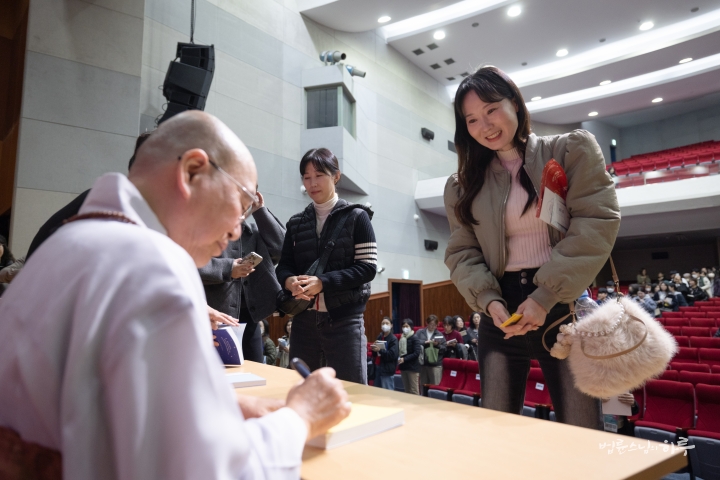
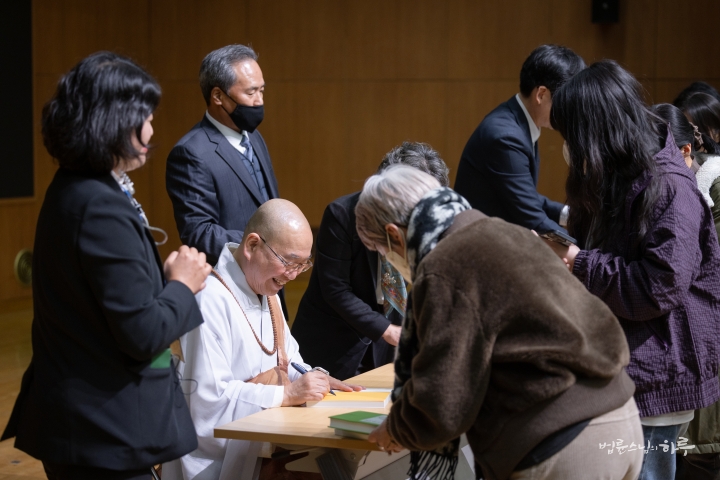
“Thanks to you, Sunim, I’m living really happily. Thank you.”
After the book signing session ended and all the citizens had left the lecture hall, Sunim took a commemorative photo with the volunteers who had prepared the lecture.
“Thank you, Venerable Pomnyun Sunim. We did well with bright smiles. Let’s go to Happiness School!”
When the volunteers shouted loudly, Sunim smiled brightly. After expressing gratitude to the Busan Happy Citizens who prepared the lecture, he left the lecture hall.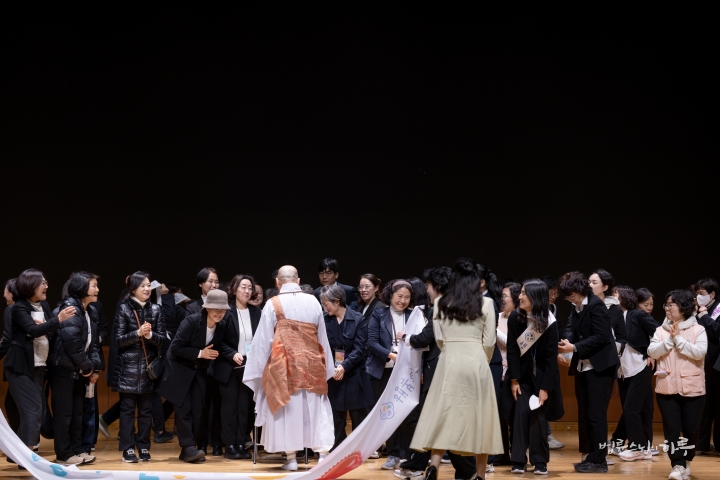
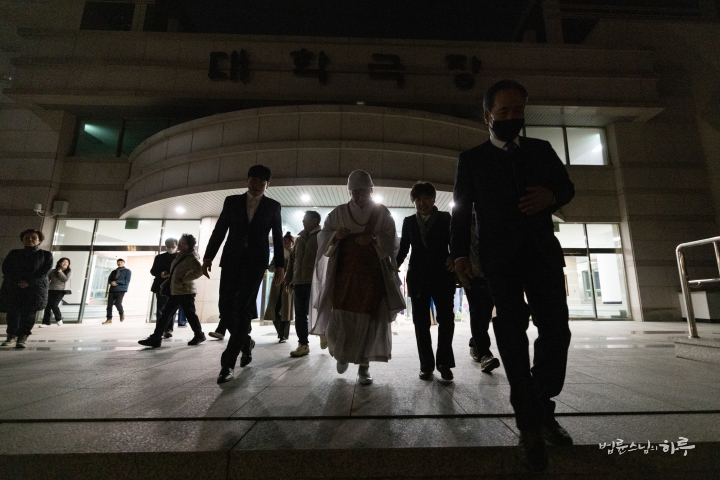
Departing from Busan at 9:40 PM, after an hour’s drive, Sunim arrived at Dubuk Jungto Retreat Center at 10:40 PM and concluded the day’s activities.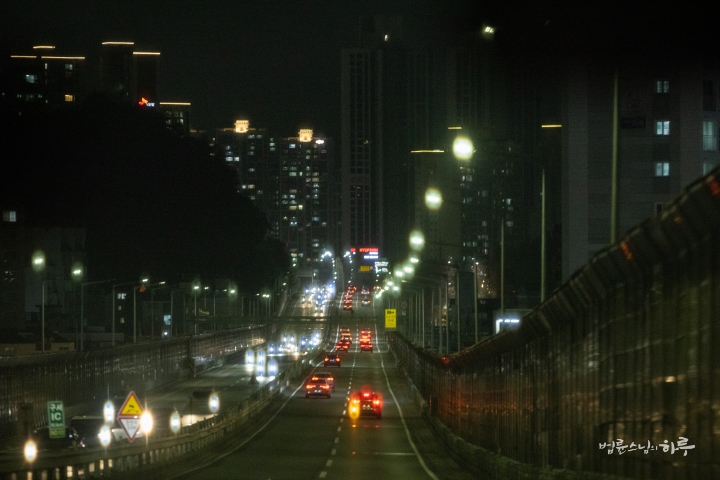
Tomorrow, Sunim will depart from Dubuk Jungto Retreat Center at 3 AM to travel to Seoul. In the morning, he will pack for his trip to Japan, and in the afternoon, he will travel to Gimpo Airport to fly to Osaka, Japan.



